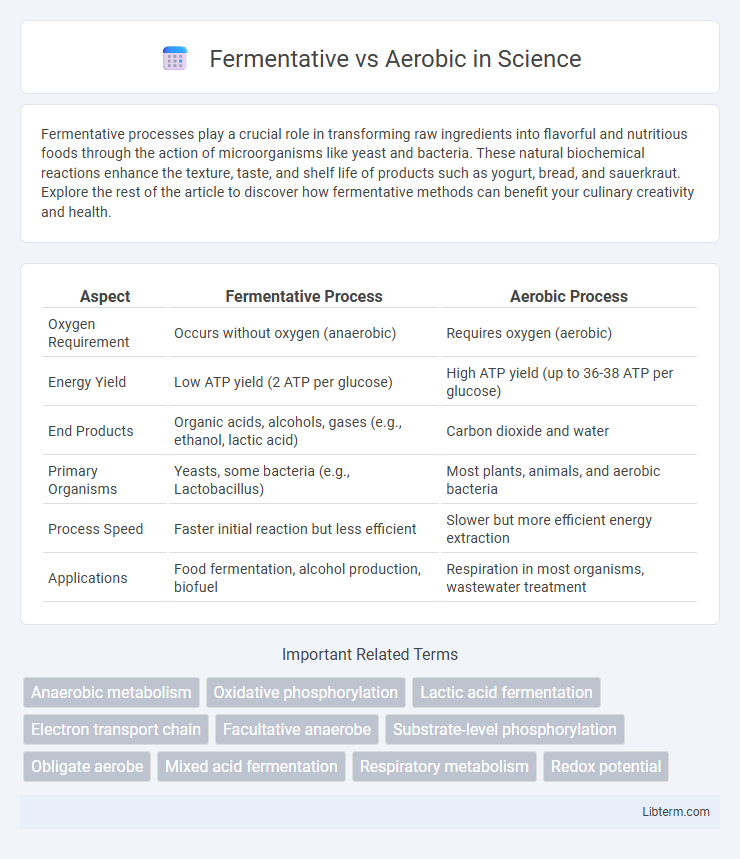Fermentative processes play a crucial role in transforming raw ingredients into flavorful and nutritious foods through the action of microorganisms like yeast and bacteria. These natural biochemical reactions enhance the texture, taste, and shelf life of products such as yogurt, bread, and sauerkraut. Explore the rest of the article to discover how fermentative methods can benefit your culinary creativity and health.
Table of Comparison
| Aspect | Fermentative Process | Aerobic Process |
|---|---|---|
| Oxygen Requirement | Occurs without oxygen (anaerobic) | Requires oxygen (aerobic) |
| Energy Yield | Low ATP yield (2 ATP per glucose) | High ATP yield (up to 36-38 ATP per glucose) |
| End Products | Organic acids, alcohols, gases (e.g., ethanol, lactic acid) | Carbon dioxide and water |
| Primary Organisms | Yeasts, some bacteria (e.g., Lactobacillus) | Most plants, animals, and aerobic bacteria |
| Process Speed | Faster initial reaction but less efficient | Slower but more efficient energy extraction |
| Applications | Food fermentation, alcohol production, biofuel | Respiration in most organisms, wastewater treatment |
Introduction to Fermentative and Aerobic Processes
Fermentative processes involve the anaerobic breakdown of organic compounds by microorganisms, producing energy in the absence of oxygen, often generating byproducts such as alcohol, acids, or gases. Aerobic processes require oxygen and enable organisms to efficiently convert substrates like glucose into carbon dioxide, water, and energy through cellular respiration. These fundamental metabolic pathways differentiate in their oxygen dependency, energy yields, and environmental applications in biotechnology, waste treatment, and bioenergy production.
Defining Fermentation and Aerobic Respiration
Fermentation is an anaerobic process where cells convert glucose into energy without oxygen, producing byproducts like lactic acid or ethanol. Aerobic respiration requires oxygen to completely break down glucose, yielding a higher energy output through the Krebs cycle and electron transport chain. These metabolic pathways differ in efficiency and byproducts, with fermentation supporting energy production in oxygen-limited environments, whereas aerobic respiration sustains higher ATP generation in oxygen-rich conditions.
Key Differences Between Fermentative and Aerobic Metabolism
Fermentative metabolism operates in the absence of oxygen, producing ATP through substrate-level phosphorylation and generating byproducts such as lactic acid or ethanol. Aerobic metabolism requires oxygen and utilizes the electron transport chain for oxidative phosphorylation, yielding significantly higher ATP compared to fermentation. Key differences include energy yield, presence of oxygen, and the type of biochemical pathways involved in ATP production.
Biochemical Pathways: Glycolysis, Krebs Cycle, and Beyond
Fermentative metabolism relies primarily on glycolysis to convert glucose into pyruvate, producing ATP anaerobically and regenerating NAD+ by reducing pyruvate into various fermentation end products like lactic acid or ethanol. Aerobic metabolism extends glycolysis by channeling pyruvate into the Krebs cycle (citric acid cycle), where it undergoes complete oxidation to CO2, generating NADH and FADH2 for the electron transport chain, resulting in significantly higher ATP yield. The presence of oxygen in aerobic pathways enables oxidative phosphorylation beyond glycolysis and Krebs cycle, maximizing energy extraction compared to the limited ATP output in fermentative pathways.
Oxygen Requirement: Presence vs Absence in Metabolic Processes
Fermentative metabolism occurs in the absence of oxygen, relying on organic molecules to generate energy through substrate-level phosphorylation, while aerobic metabolism requires oxygen as the final electron acceptor in the electron transport chain to produce ATP efficiently. Oxygen presence in aerobic processes enables complete oxidation of substrates like glucose, resulting in higher energy yield compared to fermentative pathways that produce byproducts such as lactic acid or ethanol. The oxygen requirement fundamentally distinguishes these metabolic processes, influencing cellular respiration efficiency and byproduct formation in organisms.
Energy Yield Comparison: Efficiency of ATP Production
Fermentative metabolism yields significantly less ATP per glucose molecule, typically producing only 2 ATP, compared to aerobic respiration, which generates approximately 36 to 38 ATP molecules through efficient oxidative phosphorylation. The efficiency difference stems from the complete oxidation of substrates in aerobic pathways, maximizing energy extraction via the electron transport chain and chemiosmosis. This stark contrast in ATP yield highlights the superior energy efficiency of aerobic processes in cellular respiration.
End Products of Fermentative vs Aerobic Processes
Fermentative processes primarily produce organic acids, alcohols, and gases such as lactic acid, ethanol, and carbon dioxide due to anaerobic metabolism. Aerobic processes generate carbon dioxide and water as end products through complete oxidation of glucose in the presence of oxygen. The energy yield of aerobic respiration is significantly higher, producing up to 38 ATP molecules per glucose compared to 2 ATP in fermentative pathways.
Applications in Industry and Biotechnology
Fermentative processes are widely applied in the production of bioethanol, organic acids, and pharmaceuticals due to their efficiency in anaerobic environments. Aerobic fermentation is essential in industries such as wastewater treatment, composting, and the large-scale production of enzymes, antibiotics, and amino acids by microorganisms requiring oxygen. The choice between fermentative and aerobic methods depends on the desired product yield, microbial strain, and cost-effectiveness in biotechnological applications.
Impacts on Human Health and Disease
Fermentative metabolism produces short-chain fatty acids like butyrate that support gut health by strengthening the intestinal barrier and modulating inflammation, potentially reducing risks of colorectal cancer and inflammatory bowel disease. Aerobic metabolism generates reactive oxygen species which, in excess, can cause oxidative stress linked to chronic conditions such as cardiovascular disease, neurodegeneration, and diabetes. Balancing fermentative and aerobic microbial activity in the gut influences immune function and metabolic homeostasis, critical factors in preventing metabolic syndromes and autoimmune disorders.
Future Perspectives in Metabolic Engineering
Future perspectives in metabolic engineering emphasize optimizing fermentative and aerobic pathways to enhance bioprocess efficiency and sustainability. Innovations involve redesigning microbial metabolism for increased carbon flux towards desired products under both anaerobic fermentative and aerobic respiration conditions. Advanced tools like CRISPR-based gene editing and systems biology enable precise control of metabolic networks, boosting yields in biofuel, pharmaceutical, and biochemical production.
Fermentative Infographic

 libterm.com
libterm.com